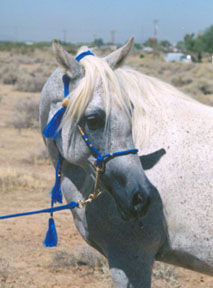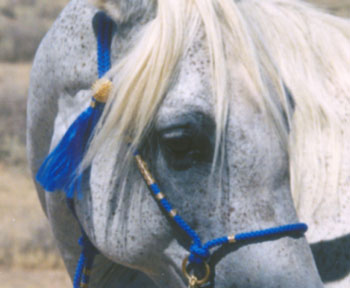
Bint Al Bahr Arabians
Preservation Breeders of Straight Babson Egyptians
 |
Bint Al Bahr Arabians Preservation Breeders of Straight Babson Egyptians |
![]()
Photo Tips - Page 9
After
the photos come back…
Your
photos now need labels. If
the photos did not come back with negative numbers printed on the back, it is
now your job to do that before the photos get shuffled and your job to do this
becomes more difficult. You need to
label them with a roll designation as well so you do not confuse negative # 12
on one roll with negative # 12 of another roll.
You can assign them with letters or numbers.
You may wish to identify the roll farther such as
BW2-14 can mean “Bint - Western tack - roll 2 – negative number 14”
Cover your negative number labeling
on the back of the photo with a scrap of scotch tape so the ink will not
transfer to the front of the next photo in the stack.
I like to order double prints so I can keep one set of labeled photos with the
negatives.
Cull your photos. Go through your photos and toss any photos that are odd angle, unflattering, eyes closed or ears back into a cull pile to throw away.
Now that you have a pile of culls, go through them one more time with these thoughts in mind. Can this body shot of Ibn when he moved his leg but has a pretty head angle be cropped to a headshot and used on your website? Was an otherwise wonderful photo culled because it was too light or too dark and would a trip to the 1 hour photo shop to do reprints that are lighter or darker save this shot?
Would
cropping save this photo? A photo can look entirely different when cropped.
Experiment with cropping. You
can use post-a-notes to crop photos and leave no damage on the photo.
Learning to crop can improve how you frame the subject in the view
finder. Look at each photo and
decide what it is you like or don’t like about each.
You can learn as much from what you throw away as you can from what you
keep.

|
This example illustrates how a cull photo can be turned into a dramatic head study with some creative cropping. (Your curser on photo will identify horse) |
 |
Throw away
the remaining culls. Do not keep any photos that
do not have some significant value in showing your horse to good advantage. Do
NOT go through your roll and select photos “you can spare” and send them out
as “better than nothing” to inquiries. A
bad photo is worse than no photo. Keep
in mind that far more people will see the photos you send out than those you kept in
your “good stack.” Toss those
cull photos away! They take up
precious storage space that will soon be needed for all those good shots you are
taking.
Get reprints
of the best photos. Make labels for the back of the photo on your computer.
I recommend that you include on your label the horse’s name, sire
and dam, birth year, sex and breeding group, when the photo was taken and the
photographers name. For example “Bint Sweetie (Ibn Studly x Sweetie), 1989 Al
Khamsa Special group mare, May 2001 Sally Shutterbug photo.”
Use tape to attach the labels to the backs of the photos.
Resist the temptation to send out unlabeled photos. Store the labels and
the negatives with the reprints so you can easily see when you need to order
more. I order at least 10 to 20
reprints of any photo I plan to use for advertising or sending out.
The fewer times that the reprint labs get a hold of your negatives, the
longer the negatives will last undamaged. Always
get more reprints before sending off your last photo. Whenever you send off your
last photo, you risk not getting it back and then forgetting to order reprints
before a need for that photo arises again.
Does this mean you shouldn’t carry your camera sometimes without any preparation just in case some horse might give you a photo opportunity? Carry your camera and you will get some great candid shots! There will always be times you will wish “If only I had my camera now.”
 Should
you take photos of muddy horses with knotted manes?
Sometimes but maybe not for advertising photos!
Most of the time your horses will look shiny and clean even if not bathed
so do take advantage of those candid opportunities as well.
Farm visitors with children can provide some good opportunities
especially with the foals. Again carry
your camera, stuff
your pockets with film and take lots of photos.
Should
you take photos of muddy horses with knotted manes?
Sometimes but maybe not for advertising photos!
Most of the time your horses will look shiny and clean even if not bathed
so do take advantage of those candid opportunities as well.
Farm visitors with children can provide some good opportunities
especially with the foals. Again carry
your camera, stuff
your pockets with film and take lots of photos.
Does
all this seem like a lot of work?
Yes, it is. Will
it all be worth it? Hopefully, most of
the time. Will there be whole rolls that are throw aways?
Yes possibly, but you can still learn from those rolls how to correct
those faults for next time. Will
you be taking the photos you always dreamed of the first time you try?
Probably not but there may be some real gems in there that will encourage
you to keep taking photos and learning what works best for you and your horses.
No gems in the pile? Not a
total loss as you can learn from those rolls and set yourself up for greater
success on the next photo shoot.
Remember a good photo shoot is a group effort and takes patience, practice and persistence!
Your cursor on the photos will tell you more about the photo and the horse.
Go back to page 1 2 3 4 5 6 7 8 9
![]()